by Bruce Wells | Oct 20, 2025 | This Week in Petroleum History
October 20, 1924 – First Tubular Goods Standards –
Shortages of equipment and drilling delays during World War I revealed the petroleum industry’s struggle with a lack of uniformity of pipe sizes, threads, and couplings. Founded in 1919, the American Petroleum Institute (API) gathered industry experts to come up with industry-wide standards to promote equipment compatibility. “After bringing these experts together to agree upon design and requirements, the first standard, Specifications for Steel and Iron Pipe for Oil Country Tubular Goods, was published on October 20, 1924,” notes API, which has since published more than 800 standards and guidelines. (more…)
by Bruce Wells | Oct 15, 2025 | Petroleum Companies
Hard lessons learned in the Wyoming Powder River Basin.
During World War I, the Winona Oil Corporation set up operations in Casper, Wyoming, with holdings of 1,200 acres of “selected land in the heart of Powder River.” The small, newly established exploration company reported having one drilling rig and another ready to be “rigged up” at another site.
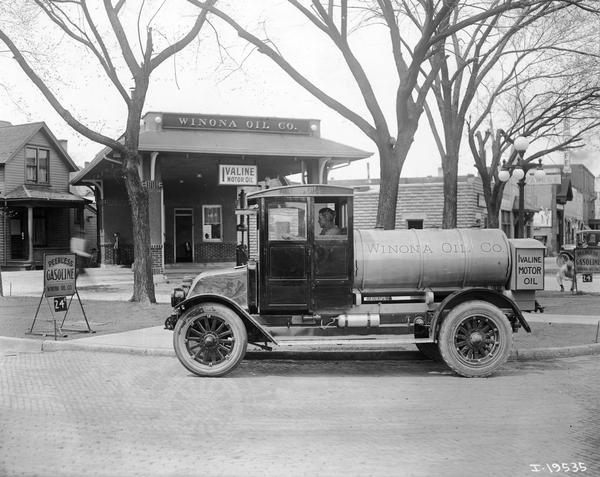
A Winona Oil Company station sold gasoline and and Ivaline Motor Oil, circa 1919. After months of difficult drilling, the company’s first exploratory well reached a depth of 700 feet without finding oil.
As the Powder River Basin attracted exploration companies, a 1918 discovery at a depth of about 2,600 feet by the Ohio Oil Company (later Marathon) would grow into the largest in the Rocky Mountains. Ohio Oil could afford drilling more productive wells a thousand feet deeper.
Along with earlier discoveries at Salt Creek (1908) and Big Muddy (1916), the Lance Creek field “brought an immediate boom and derricks sprang up everywhere,” according to the Niobrara Historical Society. The Basin’s abundant shale deposits also played a role.
With capitalization of $200,000, Winona Oil was considered a “poor boy” drilling venture dependent upon investors to fund continued drilling despite the risks. The company offered stock at 5 cents a share. Advertisements in the Ogden Standard enticed investors with “Winona Is Here to make Money, Money, Money.”

In February 1918, C. Kirchner, secretary of the Winona Oil, conducted a promotional demonstration of the reduction of shale oil to gas for about 50 onlookers. “This gas was lighted and burned during the entire experiment to such an extent that a couple of engineers in the party made the remark that the gas itself would furnish 90 percent of the fuel necessary for the original reduction,” it was later proclaimed.
This Winona Oil interest in shale oil did not develop, although other contemporary ventures did pursue it (see Ute Oil Company).
Powder River Oilfield
Winona Oil by 1919 had only been able to drill 700 feet in its first drilling effort somewhere “on the north side of the railroad.”

“Hocus Pocus-or-Common Sense?” Ivaline Motor Oil sales did not help the Winona Oil Company to survive its drilling ventures in the highly competitive oilfields of the Powder River Basin.
In March 1919, a trade magazine noted that “the Powder River Syndicate has undertaken to finish the well commenced by the Winona Oil Corporation at Powder River, Natrona Co., according to reports current in Casper.”
Another article in the Oil & Gas News added, “In the Powder River field, the Winona Oil Corporation has announced the purchase of a drilling machine which will be used to complete the company’s first well, which has been underway for months. The Winona claims to have solved all its difficulties and expects to go with its work without further delay.”
By the end of May, Winona Oil Company reportedly survived its financial difficulties and had reentered the field. Plans were by then underway to drill a second well.
Good news came the following month when the first well was described as “gassing heavily, and Casper people interested in the enterprise are very optimistic over the prospects,” the trade publication proclaimed, adding. “Should the well prove a good one, a large tract north of Powder River station would be added to the territory considered proven.”

However, by August the good news had gone bad; the gasser well had to be abandoned, “as the hole was started with a casing too small to see it thoroughly.”
Powder River Syndicate
A second well was spudded by the Powder River Syndicate with Winona Oil a fifty-fifty partner. “The Winona Powder River Syndicate well No. 2, which was begun when the first hole pinched-out, is making 100 feet a day, according to reports from the field, and is down about 500 feet. This well is located north of Powder River, on Winona holdings,” noted the Oil & Gas News on September 4.
The publication reported bad news on January 29, 1920. “The Winona well at Powder River is also shut down, but it is claimed that drilling will resume in the spring,” the News noted. “This is the second well, the first having been lost on account of a bit wedged in the hole.”
Drilling did not resume in the spring or anytime thereafter. Despite the efforts of Winona Oil and the hopes of its investors, the independent exploration company did not survive. Cities Service Company bought Winona Oil and moved the Winona division to St. Paul, Minnesota.
More articles about small exploration and production companies attempting to join petroleum booms (and avoid busts) can be found in Is my Old Oil Stock worth Anything?
______________________
Recommended Reading: Black Gold, Patterns in the Development of Wyoming’s Oil Industry (1997); Trek of the Oil Finders: A History of Exploration for Petroleum (1975). Your Amazon purchase benefits the American Oil & Gas Historical Society. As an Amazon Associate, AOGHS earns a commission from qualifying purchases.
_______________________
The American Oil & Gas Historical Society (AOGHS) preserves U.S. petroleum history. Please become an annual AOGHS supporter and help maintain this energy education website and expand historical research. For more information, contact bawells@aoghs.org. Copyright © 2025 Bruce A. Wells. All rights reserved.
Citation Information – Article Title: “Winona Corporation.” Authors: B.A. Wells and K.L. Wells. Website Name: American Oil & Gas Historical Society. URL: https://aoghs.org/old-oil-stocks/winona-oil-corporation. Last Updated: October 18, 2025. Original Published Date: March 23, 2016.
by Bruce Wells | Oct 6, 2025 | This Week in Petroleum History
October 6, 1886 – Natural Gas fuels Glass Manufacturing –
A 900-foot-deep natural gas well in a cornfield near Kokomo, Indiana, led to the establishment of the Indiana Natural Gas Company, and in 1888, the Opalescent Glass Works, which has been in continuous operation since. The state’s first natural gas well was completed in 1867, seeking oil reserves (see Indiana Natural Gas Boom).
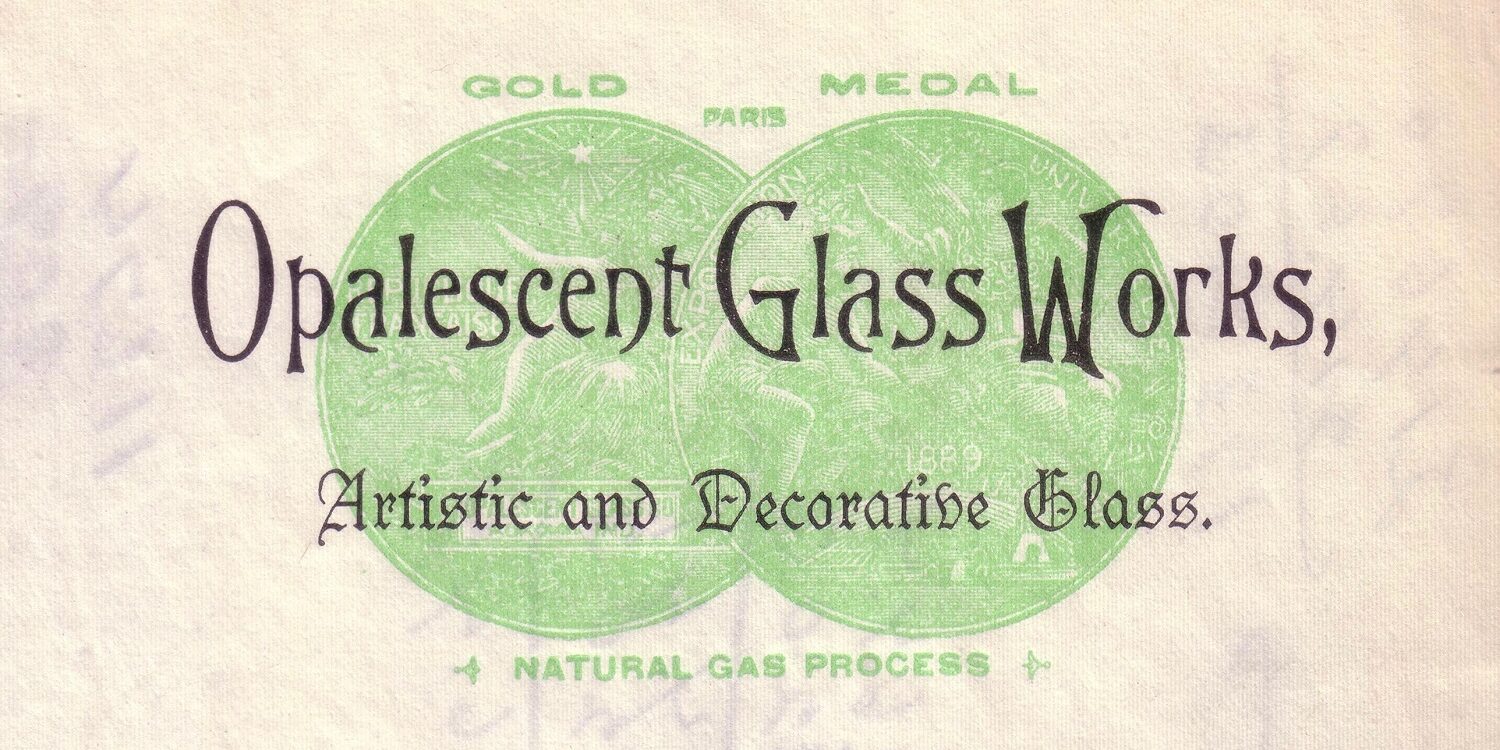
Opalescent Glass Works won a gold medal at the 1889 Exposition Universelle in Paris for its “natural gas process” glass. Photo courtesy Kokomo Opalescent Glass.
Opalescent Glass Works, today Kokomo Opalescent Glass, almost went bankrupt when natural gas supplies dwindled, but in 1893 it recovered by selling electric insulators to Edison General Electric Company — and thousands of pounds of stained glass to Tiffany studios in New York City.
October 6, 1957 – Society of Petroleum Engineers established
The first board of directors meeting of the Society of Petroleum Engineers (SPE) established the professional society in an expansion of the American Institute of Mining, Metallurgical and Petroleum Engineers (AIME), which had created a Petroleum Division in 1922.

An American Institute of Mining Engineers program led to the Society of Petroleum Engineers.
AIME began in 1871, when a small group of Pennsylvania mining engineers sought to “preserve their collective knowledge and experiences for the benefit of future engineers.” SPE has grown into an independent, nonprofit global society with 132,000 members in 146 countries.
October 7, 1859 – First U.S. Oil Well catches Fire
The wooden derrick and engine house of America’s first oil well erupted in flames along Oil Creek at Titusville, Pennsylvania. The well had been completed the previous August by Edwin L. Drake for George Bissell and the Seneca Oil Company of New Haven, Connecticut. Working with driller William “Uncle Billy” Smith, Drake used steam-powered cable-tool technology.
The first U.S. oil well fire began when Uncle Billy inspected a vat of oil with an open lamp. When the lamp’s flame set gases alight, the conflagration consumed the derrick, the stored oil, and the driller’s home. Drake and Seneca Oil Company would quickly rebuild at the already famous well site.
Learn more in First Oil Well Fire.

October 7, 2014 – 200th Anniversary of Ohio Oil Discovery
The Noble County Historical Society of Caldwell, Ohio, hosted a 200th anniversary festival and park dedication celebrating a brine well drilled with a spring pole that produced oil. The 1814 well can be found at Thorla McKee Park, named for Silas Thorla and Robert McKee, the entrepreneurs who established the local salt works, according to researcher Dave Baker in “Early Marietta.”
In 2015, Baker reported the historic well site included the remains of its original sycamore log casing beneath a replica springpole. Thoria and McKee separated the oil from the salt water by soaking it up with blankets before bottling it to sell as a medicinal potion. The remaining brine was boiled to extract the salt. In 1992, the Noble County Department of Tourism and the Ohio Historical Society dedicated a historic marker near the Caldwell site. Ohio’s first well drilled exclusively for oil was completed near Macksburg in the autumn of 1860.
October 8, 1915 – Elk Basin oilfield discovered in Wyoming
An exploratory well drilled in a remote Wyoming valley opened the giant Elk Basin oilfield. Completed by the Midwest Refining Company near the Montana border, the wildcat well produced 150 barrels of high-grade “light oil” a day. The oil needed little refining to provide quality lubricants.

“Gusher coming in, south rim of the Elk Basin field, 1917.” Photo courtesy American Heritage Center, University of Wyoming.
Geologist George Ketchum first recognized the potential of the basin as a source of oil deposits. Ketchum had explored the remote area in 1906 with C.A. Fisher while farming near Cowley, Wyoming. The Elk Basin extended from Carbon County, Montana, into northeastern Park County, Wyoming.
Fisher was the first geologist to map sections of the Bighorn Basin southeast of Cody, Wyoming, where oil seeps had been found as early as 1883. The Wyoming oilfield discovery in unproven territory attracted new ventures like Elk Basin United Oil Company, investors, and oilfield service companies.
Learn more in First Wyoming Oil Wells.
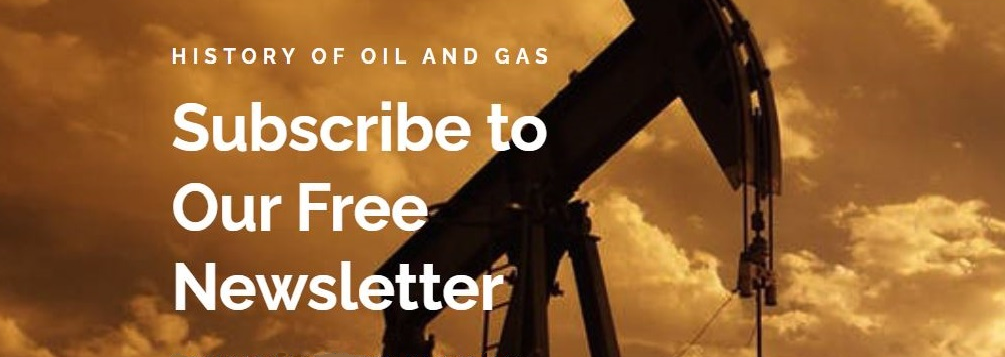
October 8, 1923 – First International Petroleum Exposition and Congress
Five thousand visitors attended the rainy opening day of the first International Petroleum Exposition and Congress in downtown Tulsa, an event that would return for almost six decades.

Although still a tourist attraction, the 76-foot-tall Golden Driller arrived decades after Tulsa’s first International Petroleum Exposition in 1923.
With annual attendance growing to more than 120,000, Mid-Continent Supply Company of Fort Worth introduced the original Golden Driller of Tulsa at the expo in 1953. Economic shocks beginning with the 1973 OPEC oil embargo depressed the industry, and after 57 years, the International Petroleum Exposition ended in 1979.
October 9, 1999 – Converted Offshore Platform launches Rocket
Sea Launch, a Boeing-led consortium of companies from the United States, Russia, Ukraine, and Norway, launched its first commercial rocket using the Ocean Odyssey, a modified semi-submersible drilling platform. After a demonstration flight in March, a Russian Zenit-3SL rocket carried a DirecTV satellite to geostationary orbit.

Ocean Odyssey, a modified semi-submersible drilling platform, became the world’s first floating equatorial launch pad in 1999. Photo courtesy Sea Launch.
In 1988, the former drilling platform had been used by Atlantic Richfield Company (ARCO) for North Sea explorations. The Ocean Odyssey made 36 more rocket launches until 2014, when the consortium ended after Russia illegally annexed Ukraine’s Crimean peninsula.
Learn more in Offshore Rocket Launcher.

October 10, 1865 – Oil Pipeline constructed in Pennsylvania
A two-inch iron pipeline began transporting oil five miles through hilly terrain from a well at booming Pithole, Pennsylvania, to the Miller Farm Railroad Station at Oil Creek. With their livelihoods threatened, teamsters attempted to sabotage the pipeline until armed guards intervened. A second oil pipeline would begin operating in December.

Oil tanks at the boom town of Pithole, Pennsylvania, where Samuel Van Syckel built a five-mile pipeline in 1865. Photo courtesy Drake Well Museum.
Built by Samuel Van Syckel, who had formed the Oil Transportation Association, the pipeline used 15-foot welded joints. Three 10-horsepower Reed and Cogswell steam pumps pushed the oil at a rate of 81 barrels per hour. With up to 2,000 barrels of oil arriving daily at the terminal, more storage tanks were soon added. The pipeline transported the equivalent of 300 teamster wagons working for 10 hours.
“The day that the Van Syckel pipeline began to run oil a revolution began in the business,” proclaimed Ida Tarbell in her 1904 History of the Standard Oil Company. “After the Drake well, it is the most important event in the history of the Oil Regions.”
_______________________
Recommended Reading: The Extraction State, A History of Natural Gas in America (2021); Myth, Legend, Reality: Edwin Laurentine Drake and the Early Oil Industry (2009); Where it All Began: The story of the people and places where the oil & gas industry began: West Virginia and southeastern Ohio
(2009); Where it All Began: The story of the people and places where the oil & gas industry began: West Virginia and southeastern Ohio (1994); Black Gold, Patterns in the Development of Wyoming’s Oil Industry (1997); Tulsa Where the Streets Were Paved With Gold – Images of America
(1994); Black Gold, Patterns in the Development of Wyoming’s Oil Industry (1997); Tulsa Where the Streets Were Paved With Gold – Images of America (2000); Offshore Pioneers: Brown & Root and the History of Offshore Oil and Gas
(2000); Offshore Pioneers: Brown & Root and the History of Offshore Oil and Gas (1997); Western Pennsylvania’s Oil Heritage
(1997); Western Pennsylvania’s Oil Heritage (2008); Oil and Gas Pipeline Fundamentals
(2008); Oil and Gas Pipeline Fundamentals (1993); Arizona Rocks & Minerals: A Field Guide to the Grand Canyon State
(1993); Arizona Rocks & Minerals: A Field Guide to the Grand Canyon State (2010). Your Amazon purchase benefits the American Oil & Gas Historical Society. As an Amazon Associate, AOGHS earns a commission from qualifying purchases.
(2010). Your Amazon purchase benefits the American Oil & Gas Historical Society. As an Amazon Associate, AOGHS earns a commission from qualifying purchases.
_______________________
The American Oil & Gas Historical Society (AOGHS) preserves U.S. petroleum history. Please become an AOGHS annual supporter and help maintain this energy education website and expand historical research. For more information, contact bawells@aoghs.org. Copyright © 2025 Bruce A. Wells. All rights reserved.
by Bruce Wells | Oct 3, 2025 | Petroleum Pioneers
A popular 1837 book by Washington Irving helped reveal natural resources of the Far West.
Tales of a Wyoming “tar spring” convinced the experienced Pennsylvania oilfield explorer Mike Murphy to drill a shallow well in 1883. He sold his oil to Union Pacific to lubricate train axles. Others would follow in the search for Wyoming oilfields.
Civil War veteran Philip Shannon explored for oil at Salt Creek outside of Casper in 1890. His well revealed what proved to be a 22,000-acre oilfield. An oil gusher drilled by a Dutch company made headlines in 1908.
But the story of Wyoming’s petroleum really began with Washington Irving, author of “The Legend of Sleepy Hollow.” (more…)
by Bruce Wells | Sep 30, 2025 | Petroleum Companies
High hopes and investments end after one well in the Big Muddy.
In October 1917, Wyoming Peerless Oil Company stock promotions first appeared in the pages of the Cheyenne State Leader, Laramie Republican, and Wyoming Tribune newspapers.

Peerless Oil and other newly formed exploration companies promoted themselves with often exaggerated newspaper ads in the Milwaukee Journal, June 2, 1918.
Within a year the new exploration company’s advertisements appeared in newspapers as far away as Milwaukee, Wisconsin: “Action Not Promises Our Motto,” noted one from 1918 placed in the Milwaukee Journal.
Many U.S. newspapers at the time included similar promotions as oilfield discoveries proliferated from California to Kansas. Just a few years earlier, Col. William F. Cody had searched for Wyoming black gold (see Buffalo Bill Shoshone Oil Company).
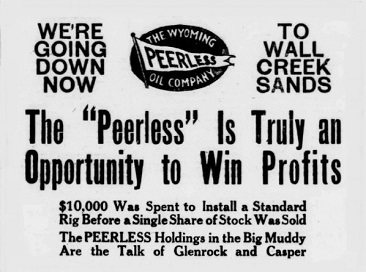
Another example of a Peerless Oil Company promotion of its Wyoming Big Muddy exploration effort.
Meanwhile, demand for gasoline had been growing since the first U.S. auto show in 1900. The Model T Fords and World War I, which the United States would soon join, resulted in a rapid proliferation of petroleum exploration companies.
Some of the startups used questionable claims to keep investors unaware of how risky and expensive the business of finding and producing oil truly was. Nine out of 10 exploratory well attempts proved to be dry holes — and petroleum exploration was expensive in such remote areas.
The Big Muddy
The Wyoming Peerless Oil Company set its sights on drilling a well six miles from the nearest producer in the Big Muddy oilfield east of Casper.
Peerless Oil stock was initially offered at three cents per share. “Don’t wait for our first well to come in. You might not be able to get this stock then for less than 25-cents or 50-cents per share.”
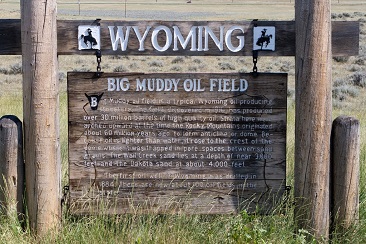
Many companies tried but failed to find petroleum wealth in the Big Muddy field.
The Big Muddy oilfield, located about four miles west of Glenrock in Converse County, was discovered in 1916, a discovery that touched off widespread drilling and brought about one of Wyoming’s famous oil booms. Today, a marker on the south side of Hwy. 230 at the junction with County Road 33 describes the historic field:
Big Muddy oil field is a typical Wyoming oil producing structure. The field, discovered in 1916, has produced over 30 million barrels of high quality oil.
Strata here were arched upward at the time the Rocky Mountains originated over 60 million years ago, to form anticline, or dome. Because oil is lighter than water, it rose to the crest of the dome where it was trapped in pore spaces between sand grains. The Wall Creek sand lies at a depth of near 3,000 feet and the Dakota sand at about 4,000 feet. The first oil well in Wyoming was drilled in 1884. There are now about 100 oil fields in the state.

The Big Muddy field in Converse County launched a drilling boom, notes a University of Wyoming’s 2019 article, Wyoming Energy History. “Claim jumpers entered the area, some only drilling at night and pretending to be construction workers on the site during the day,” the article reports, adding that 13 steam boilers were stolen — and cable-tools “lost” down holes (see Fishing in Petroleum Wells).
Peerless Oil
Seeking more investors, advertisements reported Wyoming Peerless Oil’s drilling progress on its Big Muddy exploratory well: Down 1,475 feet by June of 1918; down 1,675 feet by July and down to 3,315 feet by August of 1919.
Although rumors of a dry hole began to circulate, the company continued to solicit more investors to fund deeper drilling. But after reaching 4,050 feet without finding oil, company officer Charles Straub announced the well would be abandoned. If more funds could be secured, Wyoming Peerless Oil would drill a second well, Straub added.
“Efforts have been made to extend the limits of the (Big Muddy) field in every direction, but these efforts have all been failures, and the area of the field is plainly marked,” reported the Oil and Gas News (this would change in 1950 with a discovery to the east of the field).
By February 1920, stockholders from Denver had petitioned a court to put the Wyoming Peerless Oil Company into receivership, alleging mismanagement by Straub and other company officers. Straub responded with a $50,000 libel suit, reported by the Casper Daily Tribune on March 5, 1920. Wyoming Peerless Oil never drilled a second well, and the company disappeared from newspaper accounts.
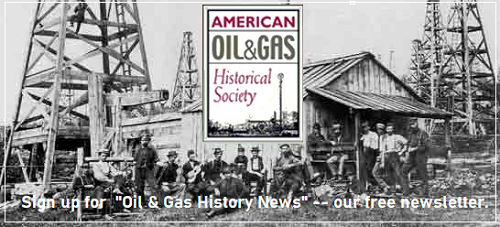
The first record of oil in Wyoming came in 1832. An expedition led by Captain B.L.E. Bonneville took the first wagons through South Pass. Fifty years later, prospector Mike Murphy bought an oil lease on the site of Capt. Bonneville’s “great tar spring” southeast of Lander.
Learn more in First Wyoming Oil Wells.
The stories of exploration and production companies joining petroleum booms (and avoiding busts) can be found updated in Is my Old Oil Stock worth Anything?
_______________________
Recommended Reading: William F. Cody’s Wyoming Empire: The Buffalo Bill Nobody Knows (2007); The Salt Creek Oil Field: Natrona County, Wyo., 1912 (reprint, 2017); Kettles and Crackers – A History of Wyoming Oil Refineries
(reprint, 2017); Kettles and Crackers – A History of Wyoming Oil Refineries (2016). Your Amazon purchases benefit the American Oil & Gas Historical Society. As an Amazon Associate, AOGHS earns a commission from qualifying purchases.
(2016). Your Amazon purchases benefit the American Oil & Gas Historical Society. As an Amazon Associate, AOGHS earns a commission from qualifying purchases.
_______________________
The American Oil & Gas Historical Society preserves U.S. petroleum history. Become an AOGHS annual supporter and help maintain this energy education website and expand historical research. For more information, contact bawells@aoghs.org. Copyright © 2025 Bruce A. Wells. All rights reserved.
Citation Information – Article Title: “Wyoming Peerless Oil Company.” Authors: B.A. Wells and K.L Wells. Website Name: American Oil & Gas Historical Society. URL: https://aoghs.org/oil-almanac/buffalo-bill-oil-company. Last Updated: October 1, 2025. Original Published Date: July 29, 2013.

















